open bonnet Alfa Romeo MiTo 2014 Owner's Manual
[x] Cancel search | Manufacturer: ALFA ROMEO, Model Year: 2014, Model line: MiTo, Model: Alfa Romeo MiTo 2014Pages: 280, PDF Size: 8.79 MB
Page 14 of 280
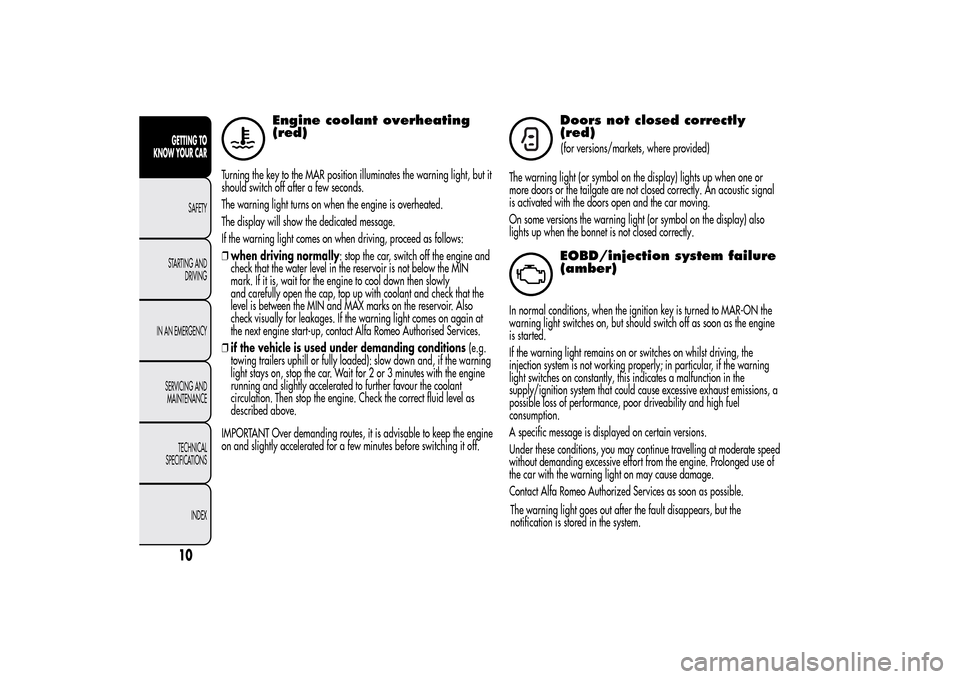
Engine coolant overheating
(red)
Turning the key to the MAR position illuminates the warning light, but it
should switch off after a few seconds.
The warning light turns on when the engine is overheated.
The display will show the dedicated message.
If the warning light comes on when driving, proceed as follows:
❒when driving normally: stop the car, switch off the engine and
check that the water level in the reservoir is not below the MIN
mark. If it is, wait for the engine to cool down then slowly
and carefully open the cap, top up with coolant and check that the
level is between the MIN and MAX marks on the reservoir. Also
check visually for leakages. If the warning light comes on again at
the next engine start-up, contact Alfa Romeo Authorised Services.
❒if the vehicle is used under demanding conditions(e.g.
towing trailers uphill or fully loaded): slow down and, if the warning
light stays on, stop the car. Wait for 2 or 3 minutes with the engine
running and slightly accelerated to further favour the coolant
circulation. Then stop the engine. Check the correct fluid level as
described above.
IMPORTANT Over demanding routes, it is advisable to keep the engine
on and slightly accelerated for a few minutes before switching it off.
Doors not closed correctly
(red)(for versions/markets, where provided)
The warning light (or symbol on the display) lights up when one or
more doors or the tailgate are not closed correctly. An acoustic signal
is activated with the doors open and the car moving.
On some versions the warning light (or symbol on the display) also
lights up when the bonnet is not closed correctly.EOBD/injection system failure
(amber)
In normal conditions, when the ignition key is turned to MAR-ON the
warning light switches on, but should switch off as soon as the engine
is started.
If the warning light remains on or switches on whilst driving, the
injection system is not working properly; in particular, if the warning
light switches on constantly, this indicates a malfunction in the
supply/ignition system that could cause excessive exhaust emissions, a
possible loss of performance, poor driveability and high fuel
consumption.
A specific message is displayed on certain versions.
Under these conditions, you may continue travelling at moderate speed
without demanding excessive effort from the engine. Prolonged use of
the car with the warning light on may cause damage.
Contact Alfa Romeo Authorized Services as soon as possible.
10GETTING TO
KNOW YOUR CAR
SAFETY
STARTING AND
DRIVING
IN AN EMERGENCY
SERVICING AND
MAINTENANCE
TECHNICAL
SPECIFICATIONS
INDEX
The warning light goes out after the fault disappears, but the
notification is stored in the system.
Page 21 of 280
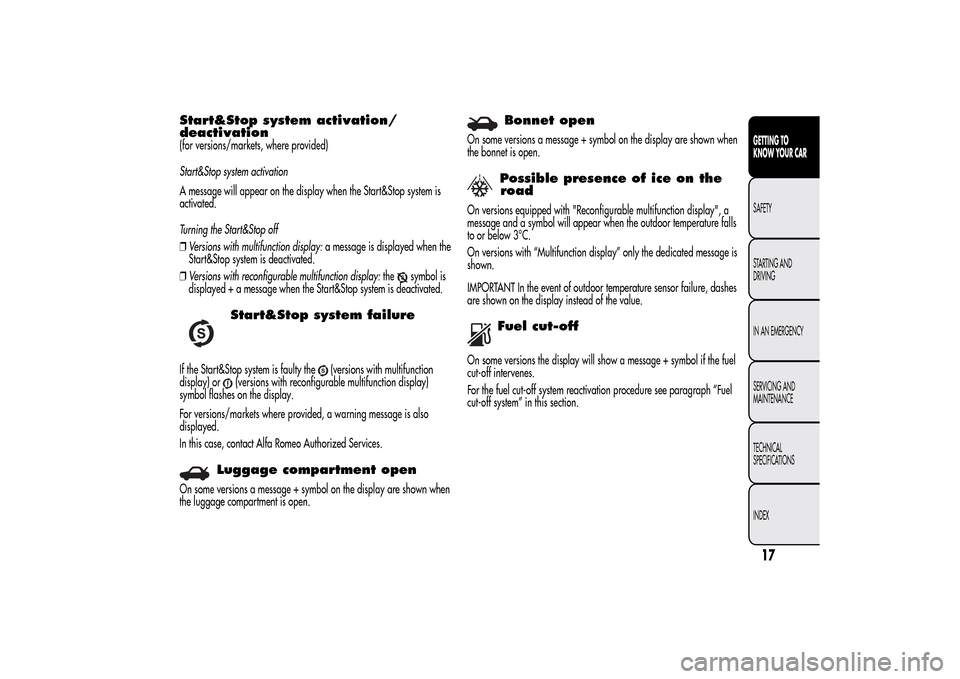
Start&Stop system activation/
deactivation(for versions/markets, where provided)
Start&Stop system activation
A message will appear on the display when the Start&Stop system is
activated.
Turning the Start&Stop off
❒Versions with multifunction display:a message is displayed when the
Start&Stop system is deactivated.
❒Versions with reconfigurable multifunction display:the
symbol is
displayed + a message when the Start&Stop system is deactivated.
Start&Stop system failure
If the Start&Stop system is faulty the
(versions with multifunction
display) or
(versions with reconfigurable multifunction display)
symbol flashes on the display.
For versions/markets where provided, a warning message is also
displayed.
In this case, contact Alfa Romeo Authorized Services.
Luggage compartment open
On some versions a message + symbol on the display are shown when
the luggage compartment is open.
Bonnet open
On some versions a message + symbol on the display are shown when
the bonnet is open.
Possible presence of ice on the
road
On versions equipped with "Reconfigurable multifunction display", a
message and a symbol will appear when the outdoor temperature falls
to or below 3°C.
On versions with “Multifunction display” only the dedicated message is
shown.
IMPORTANT In the event of outdoor temperature sensor failure, dashes
are shown on the display instead of the value.
Fuel cut-off
On some versions the display will show a message + symbol if the fuel
cut-off intervenes.
For the fuel cut-off system reactivation procedure see paragraph “Fuel
cut-off system” in this section.
17GETTING TO
KNOW YOUR CARSAFETY
STARTING AND
DRIVING
IN AN EMERGENCY
SERVICING AND
MAINTENANCE
TECHNICAL
SPECIFICATIONS
INDEX
Page 45 of 280
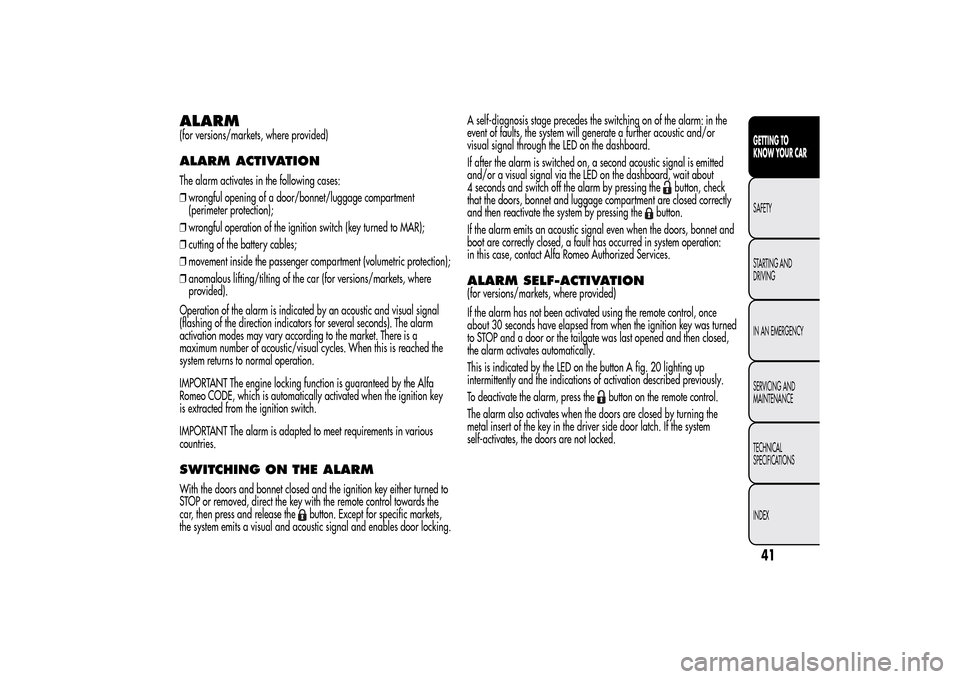
ALARM(for versions/markets, where provided)ALARM ACTIVATIONThe alarm activates in the following cases:
❒wrongful opening of a door/bonnet/luggage compartment
(perimeter protection);
❒wrongful operation of the ignition switch (key turned to MAR);
❒cutting of the battery cables;
❒movement inside the passenger compartment (volumetric protection);
❒anomalous lifting/tilting of the car (for versions/markets, where
provided).
Operation of the alarm is indicated by an acoustic and visual signal
(flashing of the direction indicators for several seconds). The alarm
activation modes may vary according to the market. There is a
maximum number of acoustic/visual cycles. When this is reached the
system returns to normal operation.
IMPORTANT The engine locking function is guaranteed by the Alfa
Romeo CODE, which is automatically activated when the ignition key
is extracted from the ignition switch.
IMPORTANT The alarm is adapted to meet requirements in various
countries.SWITCHING ON THE ALARMWith the doors and bonnet closed and the ignition key either turned to
STOP or removed, direct the key with the remote control towards the
car, then press and release the
button. Except for specific markets,
the system emits a visual and acoustic signal and enables door locking.A self-diagnosis stage precedes the switching on of the alarm: in the
event of faults, the system will generate a further acoustic and/or
visual signal through the LED on the dashboard.
If after the alarm is switched on, a second acoustic signal is emitted
and/or a visual signal via the LED on the dashboard, wait about
4 seconds and switch off the alarm by pressing the
button, check
that the doors, bonnet and luggage compartment are closed correctly
and then reactivate the system by pressing the
button.
If the alarm emits an acoustic signal even when the doors, bonnet and
boot are correctly closed, a fault has occurred in system operation:
in this case, contact Alfa Romeo Authorized Services.
ALARM SELF-ACTIVATION(for versions/markets, where provided)
If the alarm has not been activated using the remote control, once
about 30 seconds have elapsed from when the ignition key was turned
to STOP and a door or the tailgate was last opened and then closed,
the alarm activates automatically.
This is indicated by the LED on the button A fig. 20 lighting up
intermittently and the indications of activation described previously.
To deactivate the alarm, press the
button on the remote control.
The alarm also activates when the doors are closed by turning the
metal insert of the key in the driver side door latch. If the system
self-activates, the doors are not locked.
41GETTING TO
KNOW YOUR CARSAFETY
STARTING AND
DRIVING
IN AN EMERGENCY
SERVICING AND
MAINTENANCE
TECHNICAL
SPECIFICATIONS
INDEX
Page 91 of 280
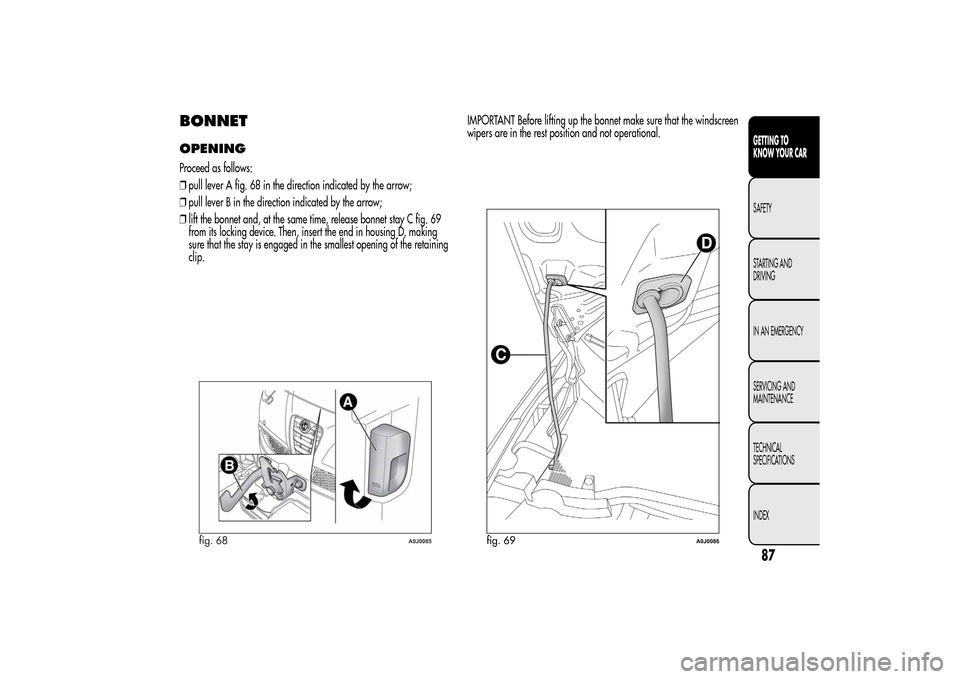
BONNETOPENINGProceed as follows:
❒pull lever A fig. 68 in the direction indicated by the arrow;
❒pull lever B in the direction indicated by the arrow;
❒lift the bonnet and, at the same time, release bonnet stay C fig. 69
from its locking device. Then, insert the end in housing D, making
sure that the stay is engaged in the smallest opening of the retaining
clip.IMPORTANT Before lifting up the bonnet make sure that the windscreen
wipers are in the rest position and not operational.
fig. 68
A0J0085
fig. 69
A0J0086
87GETTING TO
KNOW YOUR CARSAFETY
STARTING AND
DRIVING
IN AN EMERGENCY
SERVICING AND
MAINTENANCE
TECHNICAL
SPECIFICATIONS
INDEX
Page 92 of 280
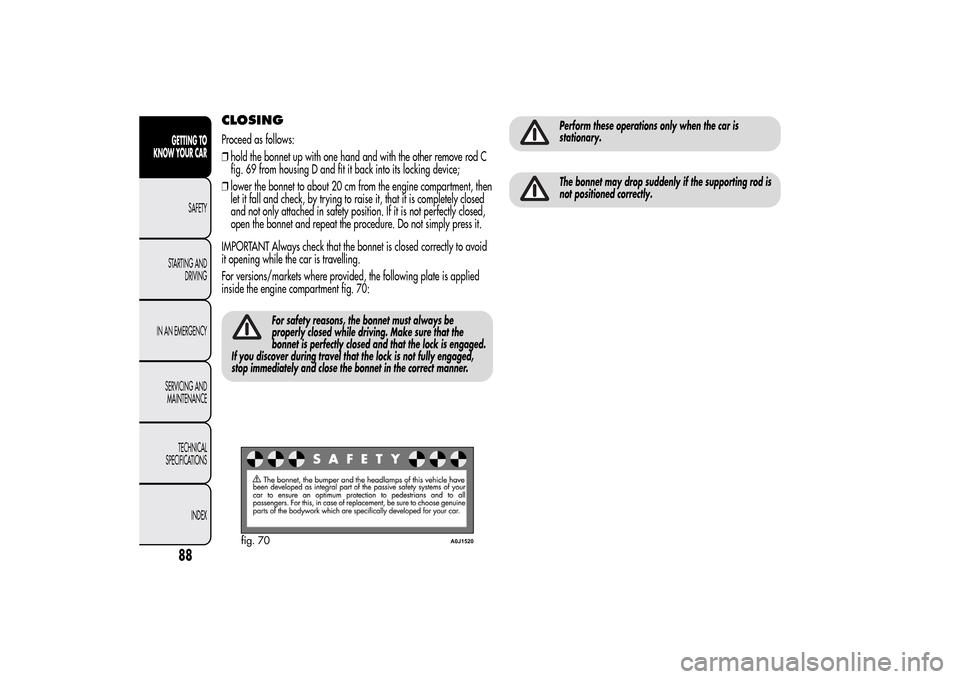
CLOSINGProceed as follows:
❒hold the bonnet up with one hand and with the other remove rod C
fig. 69 from housing D and fit it back into its locking device;
❒lower the bonnet to about 20 cm from the engine compartment, then
let it fall and check, by trying to raise it, that it is completely closed
and not only attached in safety position. If it is not perfectly closed,
open the bonnet and repeat the procedure. Do not simply press it.
IMPORTANT Always check that the bonnet is closed correctly to avoid
it opening while the car is travelling.
For versions/markets where provided, the following plate is applied
inside the engine compartment fig. 70:
For safety reasons, the bonnet must always be
properly closed while driving. Make sure that the
bonnet is perfectly closed and that the lock is engaged.
If you discover during travel that the lock is not fully engaged,
stop immediately and close the bonnet in the correct manner.
Perform these operations only when the car is
stationary.The bonnet may drop suddenly if the supporting rod is
not positioned correctly.
fig. 70
A0J1520
88GETTING TO
KNOW YOUR CAR
SAFETY
STARTING AND
DRIVING
IN AN EMERGENCY
SERVICING AND
MAINTENANCE
TECHNICAL
SPECIFICATIONS
INDEX
Page 105 of 280
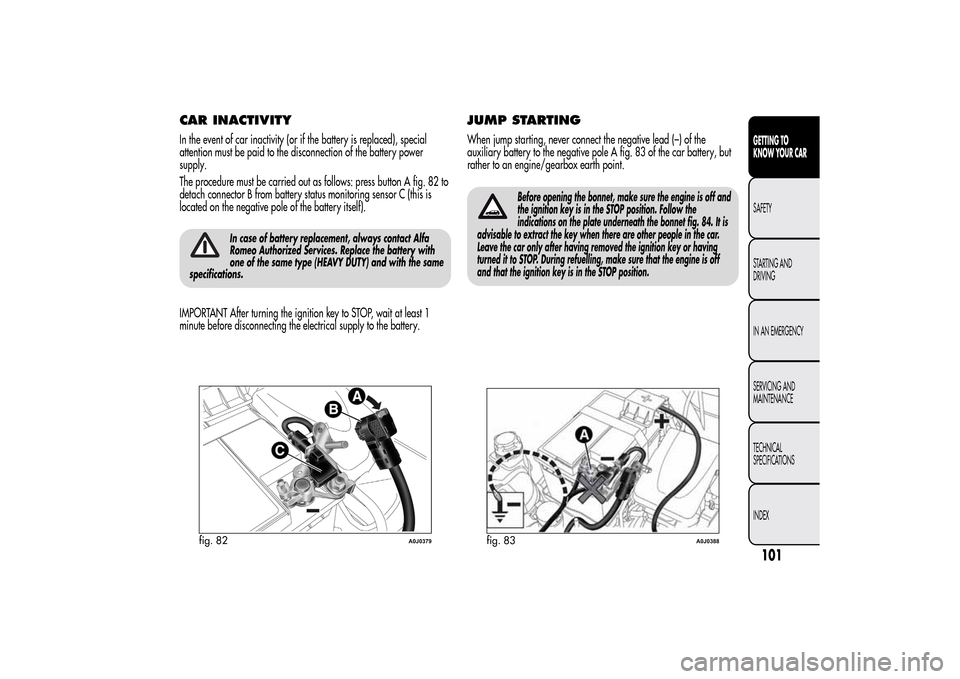
CAR INACTIVITYIn the event of car inactivity (or if the battery is replaced), special
attention must be paid to the disconnection of the battery power
supply.
The procedure must be carried out as follows: press button A fig. 82 to
detach connector B from battery status monitoring sensor C (this is
located on the negative pole of the battery itself).
In case of battery replacement, always contact Alfa
Romeo Authorized Services. Replace the battery with
one of the same type (HEAVY DUTY) and with the same
specifications.
IMPORTANT After turning the ignition key to STOP, wait at least 1
minute before disconnecting the electrical supply to the battery.
JUMP STARTINGWhen jump starting, never connect the negative lead (–) of the
auxiliary battery to the negative pole A fig. 83 of the car battery, but
rather to an engine/gearbox earth point.
Before opening the bonnet, make sure the engine is off and
the ignition key is in the STOP position. Follow the
indications on the plate underneath the bonnet fig. 84. It is
advisable to extract the key when there are other people in the car.
Leave the car only after having removed the ignition key or having
turned it to STOP. During refuelling, make sure that the engine is off
and that the ignition key is in the STOP position.
fig. 82
A0J0379
fig. 83
A0J0388
101GETTING TO
KNOW YOUR CARSAFETY
STARTING AND
DRIVING
IN AN EMERGENCY
SERVICING AND
MAINTENANCE
TECHNICAL
SPECIFICATIONS
INDEX
Page 197 of 280
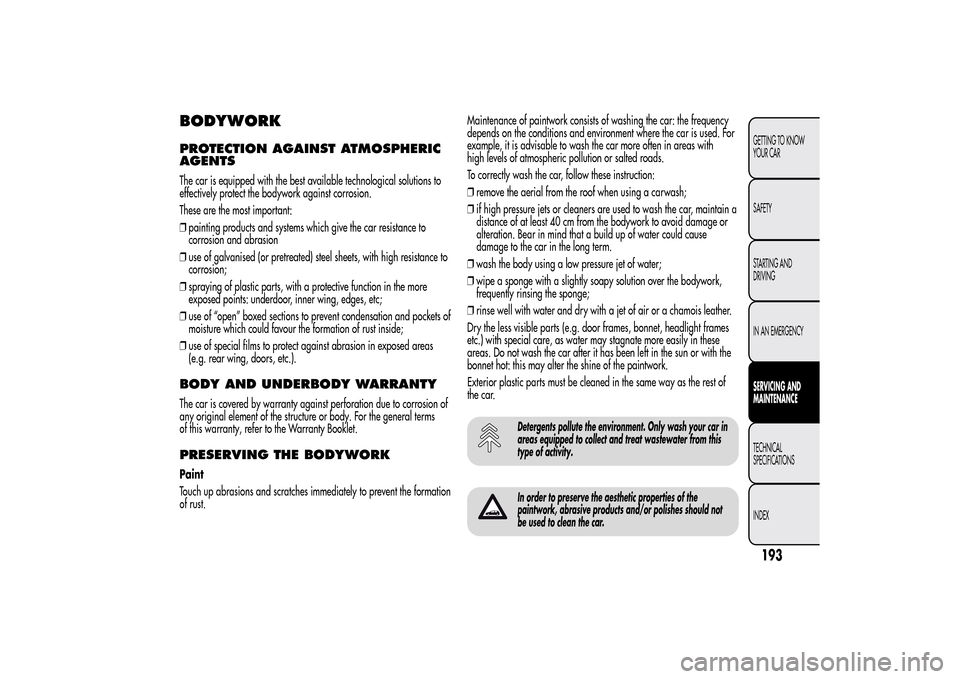
BODYWORKPROTECTION AGAINST ATMOSPHERIC
AGENTSThe car is equipped with the best available technological solutions to
effectively protect the bodywork against corrosion.
These are the most important:
❒painting products and systems which give the car resistance to
corrosion and abrasion
❒use of galvanised (or pretreated) steel sheets, with high resistance to
corrosion;
❒spraying of plastic parts, with a protective function in the more
exposed points: underdoor, inner wing, edges, etc;
❒use of “open” boxed sections to prevent condensation and pockets of
moisture which could favour the formation of rust inside;
❒use of special films to protect against abrasion in exposed areas
(e.g. rear wing, doors, etc.).BODY AND UNDERBODY WARRANTYThe car is covered by warranty against perforation due to corrosion of
any original element of the structure or body. For the general terms
of this warranty, refer to the Warranty Booklet.PRESERVING THE BODYWORKPaint
Touch up abrasions and scratches immediately to prevent the formation
of rust.Maintenance of paintwork consists of washing the car: the frequency
depends on the conditions and environment where the car is used. For
example, it is advisable to wash the car more often in areas with
high levels of atmospheric pollution or salted roads.
To correctly wash the car, follow these instruction:
❒remove the aerial from the roof when using a carwash;
❒if high pressure jets or cleaners are used to wash the car, maintain a
distance of at least 40 cm from the bodywork to avoid damage or
alteration. Bear in mind that a build up of water could cause
damage to the car in the long term.
❒wash the body using a low pressure jet of water;
❒wipe a sponge with a slightly soapy solution over the bodywork,
frequently rinsing the sponge;
❒rinse well with water and dry with a jet of air or a chamois leather.
Dry the less visible parts (e.g. door frames, bonnet, headlight frames
etc.) with special care, as water may stagnate more easily in these
areas. Do not wash the car after it has been left in the sun or with the
bonnet hot: this may alter the shine of the paintwork.
Exterior plastic parts must be cleaned in the same way as the rest of
the car.
Detergents pollute the environment. Only wash your car in
areas equipped to collect and treat wastewater from this
type of activity.In order to preserve the aesthetic properties of the
paintwork, abrasive products and/or polishes should not
be used to clean the car.
193GETTING TO KNOW
YOUR CAR
SAFETY
STARTING AND
DRIVING
IN AN EMERGENCYSERVICING AND
MAINTENANCETECHNICAL
SPECIFICATIONS
INDEX
Page 273 of 280
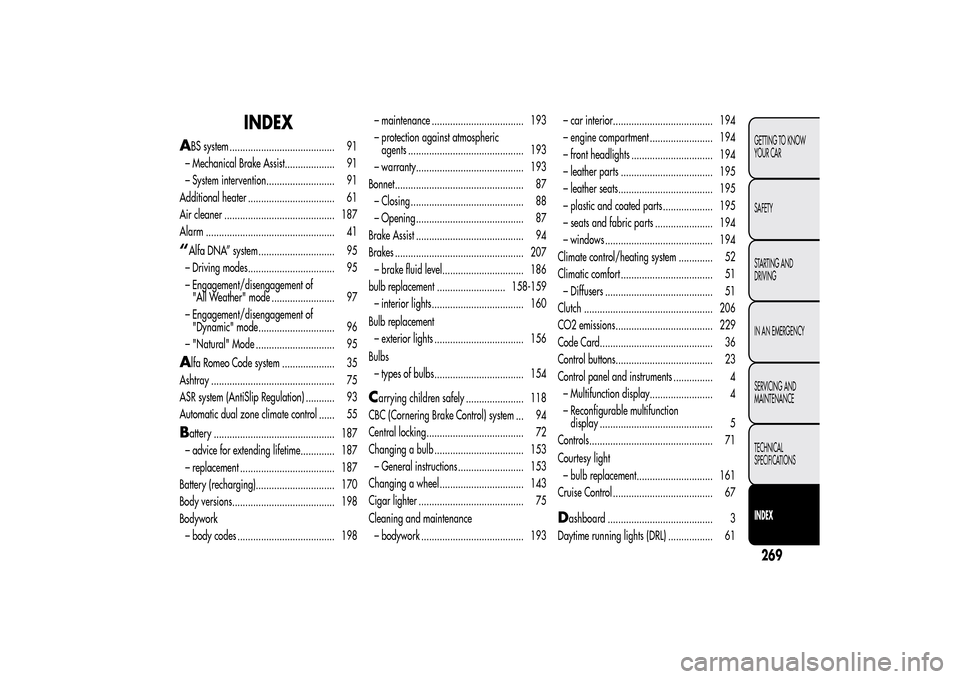
INDEX
A
BS system ........................................ 91
– Mechanical Brake Assist................... 91
– System intervention.......................... 91
Additional heater ................................. 61
Air cleaner .......................................... 187
Alarm ................................................. 41
“Alfa DNA” system ............................. 95
– Driving modes................................. 95
– Engagement/disengagement of
"All Weather" mode ........................ 97
– Engagement/disengagement of
"Dynamic" mode............................. 96
– "Natural" Mode .............................. 95A
lfa Romeo Code system .................... 35
Ashtray ............................................... 75
ASR system (AntiSlip Regulation) ........... 93
Automatic dual zone climate control ...... 55
Battery .............................................. 187
– advice for extending lifetime............. 187
– replacement .................................... 187
Battery (recharging).............................. 170
Body versions....................................... 198
Bodywork
– body codes ..................................... 198– maintenance ................................... 193
– protection against atmospheric
agents ............................................ 193
– warranty......................................... 193
Bonnet................................................. 87
– Closing ........................................... 88
– Opening ......................................... 87
Brake Assist ......................................... 94
Brakes ................................................. 207
– brake fluid level............................... 186
bulb replacement .......................... 158-159
– interior lights................................... 160
Bulb replacement
– exterior lights .................................. 156
Bulbs
– types of bulbs.................................. 154
Carrying children safely ...................... 118
CBC (Cornering Brake Control) system ... 94
Central locking..................................... 72
Changing a bulb .................................. 153
– General instructions ......................... 153
Changing a wheel ................................ 143
Cigar lighter ........................................ 75
Cleaning and maintenance
– bodywork ....................................... 193– car interior...................................... 194
– engine compartment ........................ 194
– front headlights ............................... 194
– leather parts ................................... 195
– leather seats.................................... 195
– plastic and coated parts ................... 195
– seats and fabric parts ...................... 194
– windows ......................................... 194
Climate control/heating system ............. 52
Climatic comfort ................................... 51
– Diffusers ......................................... 51
Clutch ................................................. 206
CO2 emissions..................................... 229
Code Card........................................... 36
Control buttons..................................... 23
Control panel and instruments ............... 4
– Multifunction display........................ 4
– Reconfigurable multifunction
display ........................................... 5
Controls............................................... 71
Courtesy light
– bulb replacement............................. 161
Cruise Control ...................................... 67
Dashboard ........................................ 3
Daytime running lights (DRL) ................. 61
269GETTING TO KNOW
YOUR CAR
SAFETY
STARTING AND
DRIVING
IN AN EMERGENCY
SERVICING AND
MAINTENANCE
TECHNICAL
SPECIFICATIONSINDEX